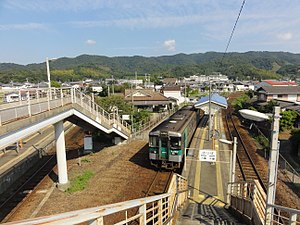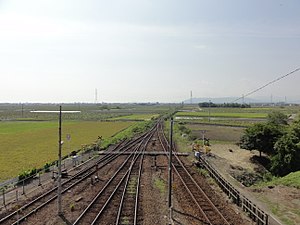Ikenotani Station
T04 N04 Ikenotani Station 池谷駅 | ||||||||||||||||||||
|---|---|---|---|---|---|---|---|---|---|---|---|---|---|---|---|---|---|---|---|---|
 Ikenotani Station in 2010 | ||||||||||||||||||||
| Location | Yanaginomoto-100 Ōasachō Ikenotani, Naruto-shi, Tokushima-ken 779-0303 Japan | |||||||||||||||||||
| Coordinates | 34°9′11″N 134°31′44″E / 34.15306°N 134.52889°ECoordinates: 34°9′11″N 134°31′44″E / 34.15306°N 134.52889°E | |||||||||||||||||||
| Operated by | ||||||||||||||||||||
| Line(s) | ||||||||||||||||||||
| Distance |
| |||||||||||||||||||
| Platforms | 2 island platforms | |||||||||||||||||||
| Tracks | 4 | |||||||||||||||||||
| Construction | ||||||||||||||||||||
| Structure type | At grade | |||||||||||||||||||
| Disabled access | No - island platforms accessed by footbridge | |||||||||||||||||||
| Other information | ||||||||||||||||||||
| Status | Unstaffed | |||||||||||||||||||
| Station code | T04, N04 | |||||||||||||||||||
| History | ||||||||||||||||||||
| Opened | 1 July 1916 | |||||||||||||||||||
| Services | ||||||||||||||||||||
| ||||||||||||||||||||
| Location | ||||||||||||||||||||
 Ikenotani Station Location within Tokushima Prefecture | ||||||||||||||||||||
Ikenotani Station (池谷駅, Ikenotani-eki) is a railway in Naruto, Tokushima Prefecture, Japan. It is the junction between the Kōtoku Line and the Naruto Line and is operated by JR Shikoku. It has two station numbers: "T04" for the Kōtoku Line and "N04" for the Naruto Line.[1][2]
Lines[]
On the Kōtoku Line, the station is 64.2 km from the beginning of the line at Takamatsu and all local trains stop.
On the Naruto Line, the station is the official start point of the line. However many of the local trains on the Naruto Line provide a through service using the Kōtoku Line track to end and start again at Tokushima.
In addition, some trains of the Uzushio limited express between Okayama, Takamatsu and Tokushima also stop at the station.[3]
Layout[]
The station consists of two island platforms set in a "V"-shape. The island platform to the west serves two tracks of the Kōtoku Line while the one to the east serves two tracks of the Naruto Line. A station building is located in the centre of the "V". This is unstaffed and serves only as a waiting room. An "E"-shaped footbridge provides access from the station building to either island platform. South of the platforms, the four tracks merge through a series of points into a single track towards Tokushima. Steps and an elevator provide access to the island platform at the second level. Parking for bicycles is available under the elevated tracks.[2][4][5]

A view of the western (Kōtoku Line) platforms looking in the direction of Takamatsu. The station building is the red tiled building partly obscured by a section of footbridge to the right.

A view of the eastern (Naruto Line) platforms looking in the direction of Naruto. The station building is in the centre and the Kōtoku Line platforms can be glimpsed to the extreme left.

South of the station, the four tracks merge into one heading to Tokushima.
History[]
- 1 July 1916: the station was opened by the privately run Awa Electric Railway (later the Awa Railway). It was an intermediate station on a new stretch of track laid down by the company from Muya to Yoshinari and the now closed Furokawa.
- 15 February 1923: a stretch of track was laid to Awa-Ōdera (now Itano) and Kajiyabara (now closed).
- 1 July 1933: the Awa Railway was nationalized and Japanese Government Railways (JGR) took over control of the station. The station was operated as part of the Awa Line.
- 20 March 1935: the station became part of Kōtoku Main Line with through traffic from Takamatsu to Sako. The stretch of track to Muya became the Muya Line with Ikenotani now designated as the official start of the line, In the process of these changes, the station was moved to its present location.
- 1 March 1952: The Muya Line is renamed the Naruto Line.
- 1 April 1987: JNR (the successor to JGR) was privatized. JR Shikoku assumed control of the station.
- 1 June 1988: the Kōtoku Main Line was renamed the Kōtoku Line.[6][7]
See also[]
- List of Railway Stations in Japan
References[]
- ^ "Shikoku Railway Route Map" (PDF). JR Shikoku. Retrieved 23 December 2017.
- ^ Jump up to: a b "池谷" [Ikenotani]. hacchi-no-he.net. Retrieved 4 February 2018.
- ^ "Ikenotani Station Timetable" (PDF). JR Shikoku. Retrieved 4 February 2018.
- ^ "池谷駅" [Ikenotani Station]. shikoku.org.uk. Retrieved 4 February 2018.
- ^ Kawashima, Ryōzō (2013). 図説: 日本の鉄道 四国・九州ライン 全線・全駅・全配線・第1巻 四国東部エリア [Japan Railways Illustrated. Shikoku and Kyushu. All lines, all stations, all track layouts. Volume 1 Eastern Shikoku] (in Japanese). Kodansha. pp. 35, 69, 70. ISBN 9784062951609.
- ^ Ishino, Tetsu; et al., eds. (1998). 停車場変遷大事典 国鉄・JR編 [Station Transition Directory - JNR/JR] (in Japanese). II. Tokyo: JTB Corporation. pp. 650, 652. ISBN 4533029809.
- ^ Ishino, Tetsu; et al., eds. (1998). 停車場変遷大事典 国鉄・JR編 [Station Transition Directory - JNR/JR] (in Japanese). I. Tokyo: JTB Corporation. pp. 215–216. ISBN 4533029809.
| Wikimedia Commons has media related to Ikenotani Station. |
- Stations of Shikoku Railway Company
- Railway stations in Tokushima Prefecture
- Railway stations in Japan opened in 1916
- Tokushima Prefecture railway station stubs




